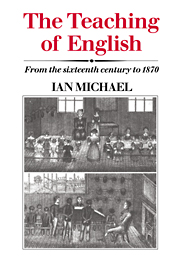Book contents
- Frontmatter
- Contents
- List of tables
- Preface
- 1 The enquiry: scope, method, texts
- 2 Reading, spelling, pronunciation: the elements
- 3 Reading, spelling, pronunciation: the skills
- 4 Interpretation: literature presented
- 5 Interpretation: literature taught
- 6 Expression and performance
- 7 Linguistic control
- 8 English: the development of a subject
- Abbreviations
- Bibliography 1
- Bibliography 2
- Bibliography 3
- Bibliography 4
- Index
2 - Reading, spelling, pronunciation: the elements
Published online by Cambridge University Press: 05 June 2012
- Frontmatter
- Contents
- List of tables
- Preface
- 1 The enquiry: scope, method, texts
- 2 Reading, spelling, pronunciation: the elements
- 3 Reading, spelling, pronunciation: the skills
- 4 Interpretation: literature presented
- 5 Interpretation: literature taught
- 6 Expression and performance
- 7 Linguistic control
- 8 English: the development of a subject
- Abbreviations
- Bibliography 1
- Bibliography 2
- Bibliography 3
- Bibliography 4
- Index
Summary
Introduction
The historical development of the teaching of reading is usually described in terms of method: alphabetic, syllabic, phonetic, phonic, look-and-say. Even though the terms are imprecise, such an analysis may sometimes be appropriate for the end of the nineteenth century and for the first decades of the twentieth, but it is not relevant to the period discussed in this chapter. The early teachers, of course, had their methods, but they did not follow, or discuss, a Method. The evidence cited in this chapter shows, perhaps surprisingly, how varied their approaches were. Their central concern was the relation between the teaching of reading and the teaching of spelling. At no time was there complete agreement as to how the two skills should be related, and during much of the period there was little conception of them as separate skills. Until well into the nineteenth century the dominant view was that reading was learnt through spelling, which should therefore precede it; but in fact the early stages of both processes were taught in such close relationship that they cannot be distinguished. There were two main reasons for the dominance of the view that reading should be learnt through spelling. The first was the belief that complex material was most easily learnt if it had been broken down into its smallest parts, which were then learnt and recombined in order: letters were studied first, then syllables, then words, then sentences.
- Type
- Chapter
- Information
- The Teaching of EnglishFrom the Sixteenth Century to 1870, pp. 14 - 89Publisher: Cambridge University PressPrint publication year: 1987

